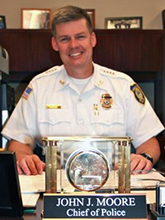
IACP NET CASE STUDY
Issue: Calls Involving Mental Illness
Police encounters with the mentally ill continue to make headlines and pose a growing demand on the resources and staff of policing organizations. In a recent survey, officers claimed that mental illness-related calls take anywhere from 20 percent to 40 percent of their time, and individual cases take significantly longer than larceny, domestic dispute, traffic, and other calls.[1]
Researchers estimate 7 percent of police contacts in jurisdictions with 100,000 or more people involve the mentally ill.[2] A three-city study found 92 percent of patrol officers had at least one encounter with a mentally ill person in crisis in the previous month, and officers averaged six such encounters per month.[3] The New York City Police Department responds to approximately 150,000 “emotionally disturbed persons” calls per year.[4]
The Holliston, Massachusetts, Police Department, however, is far above average, with police calls involving mentally ill individuals ballooning to more than 20 percent of calls in recent years. Located 21 miles west of Boston, Holliston has a population of 15,034 and an area of 19 square miles. The department serves its community with 22 sworn officers, five dispatchers, and two administrative aides.

Holliston officers respond to calls involving people with a range of mental health issues including bipolar disorder, schizophrenia, threatened suicide attempts, altered mental states due to drug and alcohol abuse, cognitive disorders, dementia, anxiety-induced crises, and autism.
Leveraging Regional Resources
“Our officers weren’t specifically trained to handle citizens with mental health issues, and we’re concerned about the safety and well-being of citizens, bystanders, and officers,” said Holliston Police Chief John Moore. “We’re the only 24/7/365 social agency that will get involved and always find a solution. We can’t say, ‘We don’t know what to do’ and walk away. We have to deal with it.”
Recognizing this growing problem and after researching jail diversion and other programs, Chief Moore looked to the example set by the nearby Framingham Police Department. Holliston and three neighboring departments took a cooperative regional approach that will save them money. The communities received a three-year grant from the Massachusetts Department of Public Health to hire a full-time clinician.
The clinician will ride with officers from the four towns, receive office space, and be available to provide advice via email or cell phone. Each town will pay $5,000 of the clinician’s annual salary. The departments are reviewing candidates and plan to hire someone this summer.
Implementing “In-House Solutions”
To further address this problem, Holliston has changed officer training and policies for handling citizens with mental health issues. The Holliston Police Department also collaborates with the school resource officer to discuss students who are having problems, sponsors community forums to discuss emerging problems such as opiate abuse, and hosts speakers including a former NBA player with a long history of heroin abuse.

John J. Moore, Chief of Police, Holliston Police Department
“We’re trying to proactively address mental health issues by gathering information and ideas, networking, and consulting with other chiefs at the county and state level,” said Moore. “There’s no better resource than IACP Net to get ideas, look at problems, and see how other departments have handled them.”
In addition, each year several of Moore”s officers attend Mental Health First Aid, receiving crisis intervention training and learning skills that allow them to respond to signs of mental illness and substance abuse. It also covers “suicide by cop” situations and mental health issues that officers face due to job stress.
The impetus to improve handling mental health emergencies came from a community forum a year ago. Moore had submitted a capital request to purchase TASER® conducted electrical weapons and thought it would be a cost issue, but the unanticipated response gave him pause.
“Someone asked, ‘What will you do with TASERs? Electrocute everyone with a mental health issue? What training do you have to handle these calls?'” said Moore. “It led us to think more about the problem and how to address it more effectively. We improved our training and it has given our officers greater confidence and made us a better department.”
Moore is very pleased there haven’t been any use-of-force complaints or suspect injuries in the four years he’s been chief. The former practicing lawyer keeps civil liability issues in mind, and knows an incorrectly handled situation can lead to deadly force issues—and unwanted nationwide coverage on the nightly news.
Moore also appreciates IACP Net as a valuable source of information, networking, training and grant opportunities, and Supreme Court case reviews. Briefing papers provide a wide-angle view of issues and Moore finds them much more interesting than policies.
“Now if citizens ask, I can say, ‘We anticipated these problems. Here’s how we trained our officers and brought in an outside clinician to solve them,'” said Moore. “I’m a big proponent of cross training and professional development. I sleep better and I have full confidence my officers are better equipped, better at their job, and the town is better off.”
AGENCY STATS
Holliston Police Department
Location:
Holliston, Massachusetts
Department Size
22 Sworn Officers
Area and Population Served
City of Holliston, Population 15,034
Leadership
John J. Moore, Chief of Police
David J. Gatchell, Lieutenant
Craig W. Denman, Lieutenant
End Notes:
[1] Biasotti, “Management of the Severely Mentally Ill and its Effects on Homeland Security,” (2011).
[2] Deane et al, “Emerging Partnerships Between Mental Health and Law Enforcement,” Psychiatric Services, 50, no. 1 (1999).
[3] Borum et al, “Police Perspectives on Responding to Mentally Ill People in Crisis: Perceptions of Program Effectiveness,” Behavioral Sciences and the Law, 16, no. 4 (1998).
[4] Waldman, “Police struggle with approach to the mentally ill,” The Christian Science Monitor, March 17, 2004.
Download a PDF of this case study, which also includes an overview of a CIT program from the IACP Net e-Library.